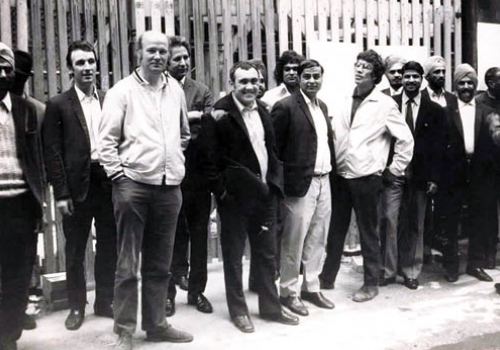Home >> News >> 2011 >> Aug >> Property News: The ‘labourers’ who rebuilt London after destruction of war
Property News: The ‘labourers’ who rebuilt London after destruction of war

Published: 05 August 2011
by DAN CARRIER
THEY were the men who rebuilt London after the hardship of the 1930s Depression and the destruction of the Second World War.
But despite their integral role in helping to shape modern Britain, the stories of the blood, sweat and tears spilled by builders has not yet been told. University of Westminster academic Professor Linda Clarke hopes to change that and is currently researching and chronicling the stories of the men who toiled on sites, creating iconic structures such as the Barbican Centre, the M1 motorway, Sizewell A nuclear power station, and other massive projects that helped kickstart the post-war economy and transform a 19th-century industrial landscape.
Professor Clarke told the New Journal that her research project – which she has titled “Constructing Post-War Britain: building workers’ stories 1950-70” – would not only ensure their stories are not forgotten, but would also help us understand that era’s industrial disputes, working conditions, health and safety, pay, training and apprenticeships, the black market economy, cash-in-hand work, and migration.
“For the last year we have been tracing and recording the memories of the building workers who built post-war Britain”, Professor Clarke said. “Many of these lived and still live in the Camden area and we are collecting the stories of men who helped to build some of the highest-profile housing and architectural developments of the post-war period.
“The aim of the research is to give building workers on these developments a chance to tell their stories and so to increase our understanding of the construction industry then and now.”
The construction projects Professor Clarke has examined include those that used what was then ground-breaking technology such as reinforced concrete.
Both the Barbican and the South Bank complex used new materials and techniques.
Professor Clarke added: “Workers on the construction of the Barbican have told of the accuracy needed in building with in-situ concrete, the frustration of driving slow cranes, the skills needed for complex scaffolding and all the problems associated with seemingly arbitrary bonus systems – leading to numerous disputes and hardship for those on strike.
“The South Bank arts complex, like the Barbican, was also constructed in the ubiquitous material of post-war architecture: concrete.
“On the Queen Elizabeth Hall the concrete finish required meticulous attention to detail in the construction of the framework and highly skilled joiners made up the boards in a workshop on-site, while the concrete gangs were made up of carpenters – many of them Sikh and Afro-Caribbean.
“Although classed as ‘labourers’, these gangs were certainly not ‘semi-skilled’ and one of the site managers remembers the same gang spending the morning hanging and fitting hardwood doors on one part of the site and striking shuttering in the afternoon.”
• Professor Clarke and her colleague Charlie McGuire are looking for people who worked on the following projects between 1950 and 1970 for their project: The Barbican, City of London; Stevenage New Town; The Shell Building, South Bank; The South Bank Arts Complex; Sizewell A Nuclear Power Station; and the M1 motorway. They can be contacted on 0207 911 5000 extension 3158 or 07826 255555.




Comments
Determinations
Submitted by Anonymous on Sat, 2011-08-13 22:37.What a cheek. The clarification later in the piece is little use when the title talks of 'labourers'. In the building and construction world 'labourers' - much needed of course, are there to fetch, carry and clear up. The builders who executed the works are SKILLED tradesmen, their seconds and trainees or apprentices.
About time the writing classes learnt this - or shall we call ms Clarke a typist - able to because she can 'read n write'' ?
Colin
Peckham
Post new comment